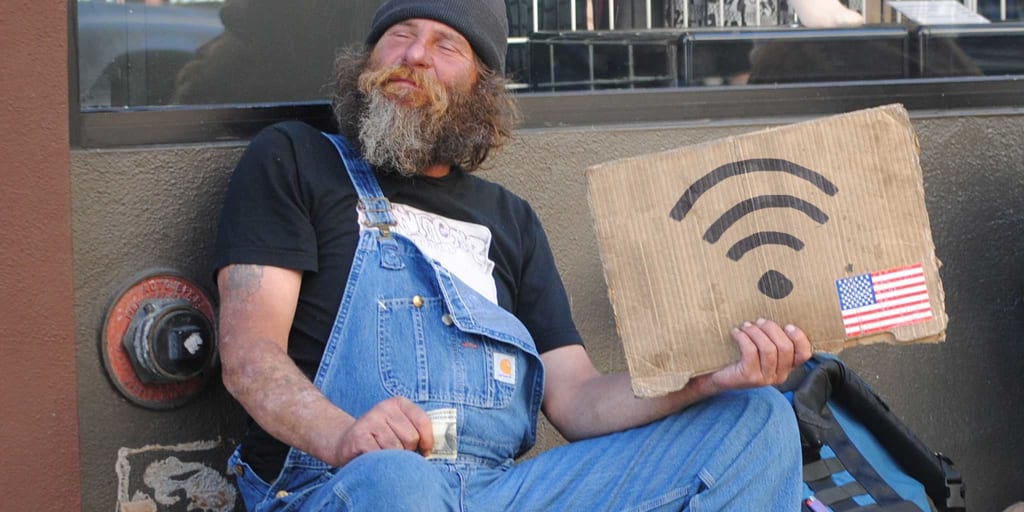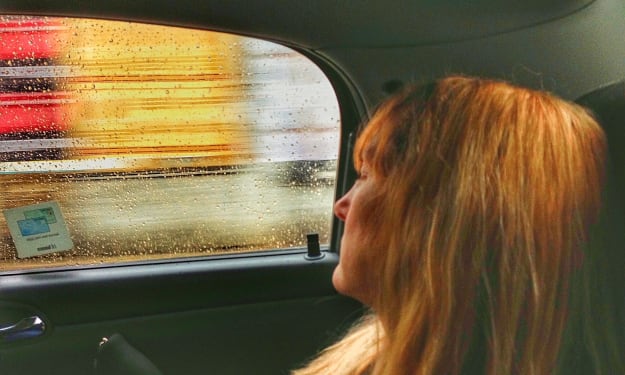Hungry And Homeless In America
Where will you spend the holidays? According to statistics provided by the United States Census Bureau, greater than 45 million Americans live below the bureau’s calculated poverty level. A great many of this number will be homeless and hungry during the holidays. In 2015, more than 750,000 families and 1.35 million children across this great nation were homeless in that they had no permanent roof over their heads, “rough sleeping” on the street, seeking shelter from the elements underneath trees, park benches, and highway underpasses.

The most recent statistics on the homeless show an unsettling truth that few of us want to hear. These alarming statistics hit awfully close to home—and to the fact that any one of us, due to an unanticipated medical challenge, sudden unemployment, housing loss, or other unanticipated life event—can easily wind up on the street.
There is no argument that the United States is the undisputed superpower of the world regarding military might and political influence. However, a huge disparity in income means there are many in the US who are simply being left behind. During the 1980s the number of homeless persons in the United States skyrocketed following a deteriorating economy, federal cuts to low-income housing programs and a national trend towards deinstitutionalization of mental health care.
The National Center on Homeless and Poverty reports that today, 31 million people love on the edge of hunger in this country. Despite extensive efforts on the city, state and federal level, homelessness in many states has increased dramatically since the financial crisis of 2008.
Many persons living on the edge of desperate poverty discover that efforts to improve work skills to earn higher wages may cause disqualification for a good many forms of public assistance. Services such as day care support are only provided at poverty wages or while on unemployment. Any increase in income is offset by rising cost of living expenses. For a significant number of households near the bottom of the wage scale, holding down a full time or even two jobs may not be adequate to avoid a precarious housing situation.
Families and individuals facing housing instability seek shelter and a safe place to sleep wherever they can. This can mean sleeping on the sidewalks, in city parks, on the beach, and other places not meant for human habitation, often at the risk of being caught and told to move on. Others have created modern-day shantytowns, living in tents and packing crates while still others seek temporary, non-shelter housing like cheap motels and hotels. A huge sub-stratum of the homeless population squat in abandoned buildings.
A homeless person, according to the Stewart Mc Kinney Homeless Assistance Act of 1987, is any person who lacks housing and those whose primary residence is in a shelter or private facility that provides temporary living conditions. GoodMenproject.com advises that there are stages to homelessness, and sleeping on the street is the last stage, noting, “Homelessness begins when you get evicted, and then you spend time 'sofa-surfing' until you've worn out your welcome at all your friends' and relatives' houses, and then you exhaust whatever public housing or shelter options are available, and only then do you wind up as a visible 'homeless person.' But people at every stage of this process are, in fact, homeless.”
The estimated number of homeless persons cannot begin to include the many people “living” in their vehicles, crashed on a friend’s floor, or riding the rails. How many remain uncounted?
TheEpochTimes.com reports, “Many homeless sleep huddled close to buildings for protection from the elements. Most likely they are trespassing on private property, for which they can also be arrested. Last year, a homeless man who sought shelter in the stairwell of a public housing building in Harlem was charged with trespassing in the second degree, a misdemeanor. A judge set his bail at $2,500, which he wasn't able to pay, according to reports by The Associated Press. He later died in his overheated jail cell when guards neglected to check on him.”
Although the homeless do not conform to any one general description, persons experiencing poverty and homelessness share basic needs, including affordable housing, adequate incomes, and health care. Others may require additional services such as mental health and drug treatment to remain securely housed and to re-enter into the mainstream culture. All basic human needs must be met to prevent and end homelessness.
The Escalating Number of Homeless in the United States
A huge number of people in America are counted as sheltered only because they are incarcerated or in medical care facilities. In many cases, although temporary, health-related therapy may result in homelessness upon discharge or release.
The SedonaObserver.com reports “Another 650,000 prisoners will be released onto the street this coming year, only adding to the homeless statistics. Unable to get jobs due to a prison record and lack of housing, most will have nowhere to go.”
In a recent article, "Bridging the Divide," ChallengerNewspaper.com reports, “Official statistics on the exact problems homeless people face are difficult to obtain. The U.S. Department of Housing and Urban Development releases an Annual Homeless Assessment Report, but it contains little more than an estimate of the number of people on the streets. More helpful would be numbers on the ailments that homeless people are widely assumed to suffer: mental illness, drug problems, and alcohol abuse. The National Coalition for the Homeless, a large advocacy organization, estimates that 20-25 percent of the adult homeless population suffers from the severe mental illness. Other estimates are as high as 50 percent, depending on how mental illnesses are classified. The U.S. Interagency Council on Homelessness estimates that nearly half of all homeless people also suffer from some form of substance abuse.”
An annual Point-in-Time Homeless Count determines the most reliable picture of the plight of the homeless in the United States. Taking place in January 2016, the Point-in-Time Homeless Count is a requirement by the U.S. Department of Housing and Urban Development (HUD) for every community receiving federal funds for programs to aid the homeless. The count is mandated to take place at least biennially during the last two weeks of January.
High Cost of Housing Drives an Increase in Homelessness Across America
Many people live on the brink of eviction and foreclosure with 6.4 million American families at risk of homelessness due to a lack of affordable housing, paying out more than 50 percent of their income for rent. "They're like a deer caught in headlights," said Kimberlee Reinking, with the Housing Resource Center of Michigan’s Allegan County. "We're seeing people who have never had to deal with anything like this.”
The diminishing availability of affordable housing is a primary contributing factor in literally kicking families out onto the curb. Government economists predict that with a consistent increase in the cost of housing, accompanied by a stagnant salary environment, this figure will only continue to rise.
As we enter 2017, the high cost of living, low-wage jobs, and escalating unemployment rates force countless Americans to struggle to choose between food, housing, medical care, and other necessary cost-of-living expenses. Someone who works full-time at a minimum-wage job takes home about $900.00 per month and is at great risk for homelessness.
The official government counts of homeless persons are somewhat distorted in that many families with young children find ways of avoiding an outright loss of shelter by making severe financial sacrifices in other ways that avoid the recognition as functionally homeless. However, no matter the availability of a diverse array of forms of financial and housing assistance, many families are unable to overcome a lack of hope, unemployment, incarceration, illness, domestic violence, substance abuse, or mental health issues from forcing them onto the streets.
The homeless problem isn’t going away, and it doesn’t seem to be getting any better. The reasons people become homeless include but are not limited to, loss of employment, drug or alcohol addiction, disabilities, mental health issues, and escape from domestic abuse.
The Changing Face of Homelessness in America
PriceEconomics.com reports, “Homelessness in America today is very different than it was 40 years ago, statistically speaking. In the 1980s, the number of homeless people in the United States ballooned—following a deteriorating economy, a national trend towards deinstitutionalization of mental health care, and federal cuts to low-income housing programs.”
America’s homeless population is as diverse as its citizens. The homeless sub-culture of America is an eclectic group of people with a certain set of beliefs, social forms, and or way of life of a set of people in a certain time frame. It is important to remember that homeless people make up a diverse group which includes all religious sects, all ethnics, and men women and families from all walks of life. However, those persons facing homelessness have two main commonalities—they experience dismal poverty and they are unable to access safe and affordable housing.
As many as 57 percent of the nation’s homeless suffer serious psychiatric disorders. This percentage is in comparison to the six percent of the general population that is suffering from some form of a mental illness at any given time. For those persons “on the street” with a mental illness that are chronically homeless, the mortality rate is 2.5 times greater than those who are homeless without a mental illness. Not only is a mental illness devastating and incapacitating to those who are suffering from it, but in many cases, the illness is the primary reason why a person or a family has become homeless in the first place.
37 percent of America’s homeless population suffer depression and 48 percent have a severe physical disability. The majority have suffered domestic or child abuse, many have lost their jobs after decades of employment, or been abandoned or “kicked-out” by their family: Most have lost their wealth, their health, their families; all have lost their homes.
Sadly, many of our country’s homeless face frigid winter temperatures, bitter wind, rain, and snow, while they search for a warm and well-lighted area to reduce the likelihood of falling victim to criminal activity.
In the United States, homelessness is a disheartening, tragic, and complex social problem with a diverse array of causes. For cities, states and federal agencies, it has become an uphill task to attempt to find the causes, effects, and solutions to the ever-escalating number of homeless persons in America.
The faces of the homeless are as diverse as the reasons. The image of the homeless no longer fits the traditional picture of the “alcoholic bum” sleeping it off it off in a doorway. Contrary to the stereotype of the homeless as chronic alcoholics, government statistics indicate only 35 percent had alcohol abuse issues. While many homeless persons end up on the streets as a result of their poor choices, the majority claim themselves victims of extenuating circumstances that propelled their lives in a downward spiral of desperation.
The National Centre on Homelessness and Poverty estimated that half of all homeless people are African-American and that 44 percent of all homeless are single men. Adult males between 30 and 50, make-up the largest share of homeless at 55 percent. GoodMenProject.com advises, “It is necessary not to erase the existence of women who are homeless. Even though men are more likely to be homeless, homelessness is a lot more gender equal than a lot of people present it.
The primary causes of homelessness—poverty, lack of affordable housing, unemployment—affect everyone, regardless of gender. A large percentage of the increase in homeless families is probably caused by the recession: unemployment and lack of affordable housing were the two most commonly cited causes of the increase in homeless families. It is important to note that there may be reasons why women are more likely to be housed than men that still don't mean the women are in a particularly good situation. For instance, women are more likely to participate in survival sex in exchange for housing. 'Survival sex or homelessness,' however, is one of those dilemmas that really leaves no one in a particularly good situation.”
Elderly men accounting for approximately 15 percent of the United States' homeless population with elderly women making up another 8 percent. Sadly, the fastest-growing segment of America’s homeless population is women under 40 and children.
Young people between the age of 12-to-17, typically runaways from parental abuse and neglect or those exiting the foster care system, account for greater than ten percent of the of America’s homeless. A large number of complex conditions characterize former foster children in terms of homelessness. Foster children tend to be transient in adult life, lack positive role models, and fail to develop the motivation to please anyone other than themselves.
Nationally, one in five persons in a soup kitchen line is a child. The US Department of Education recently released a report indicating that in 2013, nearly 1.3 million children enrolled in public schools experienced homelessness.
Many homeless children are alone at the holidays, neglected and homeless, either runaways or "throwaways." 20 percent of the estimated 750,000 homeless persons in this country fall into the category of children ten years old and younger. Many of these children have never known what it is like to live in a real home.
Communities Struggle to Find Answers to the Homeless Problem
The “Housing First” concept works to eliminate chronic homeless. Persons who are frequently homeless cause huge financial burdens for communities, including public safety agencies, law enforcement, jails, and hospitals. Recently published social research in the United States indicates that providing immediate and permanent housing for such people is less expensive than responding to crises caused by homelessness.
U.S. Government Frustration
Political candidates of both parties in the current presidential campaign rant and rage on about the plight of the homeless in America, but offer little in the way of substantive change or workable solutions. Government officials currently working on the problem voice their frustration, noting, “To date, a diverse a variety of governmentally funded programs exist to assist the homeless. Unfortunately, effective strategies run counter to the ideologies, beliefs and expectations of citizen groups and political parties. In addition, our elected representatives often seek politically expedient, simple and short-term solutions to complex social and health problems. The controversy surrounding strategies like social housing and harm reduction are filled with emotion and strong positions. However, like all complex social issues, they are seldom explained in a short sound bite or within the mandate of a political party despite their best intentions. Successful models require a long-term integrated strategy that is not solely driven by short-term cost savings.”
The National Coalition For The Homeless released studies showing that programs designed to assist the homeless should be implemented to cover a variety of concerns. An evaluation of the Job Training for the Homeless Demonstration Program (JTHDP), authorized by the Stewart B. McKinney Act in 1988, found that successful employment programs provide access to a wide variety of services including housing to assist the homeless overcome employment barriers. In addition, the evaluation concluded that in order for employment programs to be most successful, they must directly target the homeless or those at risk of becoming homeless.
An article, "Homeless and Health," said, “The cost of homelessness to society as a whole and to homeless people themselves goes well beyond the nuisance of public intoxication and pan handling and the impact on tourism. Despite our attempts to socially isolate homeless people, they are responsible for a disproportionate use of judicial, social and health care resources. At the same time, they do not materially benefit from this investment as they, for example, have similar health indices as those living in underdeveloped countries. Their age-adjusted mortality is 2- to 8-fold greater than the housed population. Those living on the streets suffer from the same spectrum of medical illness as the housed population, yet the frequency of illness is substantially higher among homeless people. In addition, they may suffer from psychiatric disease, mental and physical disability and the consequences of drug and alcohol abuse, including violence, sexual exploitation and infectious diseases such as tuberculosis, HIV and hepatitis C. For example, the incidence of diseases such as diabetes and HIV in the chronically homeless population are substantially higher than in the housed population.”
Cautious Compassion
If you have been wondering how you can get involved to address homelessness in your community, Neighbor-2-Neighbor program is great place to start. Neighbor-2-Neighbor (N2N) is similar a buddy system created to support neighbors experiencing homelessness as they prepare to secure and maintain housing.
References:
Homelessness Isn’t a Crime, But When You Are Homeless, You Are Breaking the Law
How U.S. Cities Count Their Homeless
Housing the Homeless In Tooele County - Wasatch Front Regional
Poverty and human development: Homelessness and health
Homelessness and Poverty in America: Stats adding to the confusion - Naples Herald
Half West Michigan's 13,332 homeless residents are without housing for the first time
Are Men More Likely To Be Homeless?
Bridging the Divide | the Challenger
Indiana's Homeless Population Decreases in 2015 Point-in-Time Homeless Count | XRB Radio
ArizonaNews
About the Creator
Marlene Affeld
“A passionate writer for more than 30 years, Marlene Affeld’s passion for the environment inspires her to write informative articles to assist others in living a green lifestyle.”






Comments
There are no comments for this story
Be the first to respond and start the conversation.